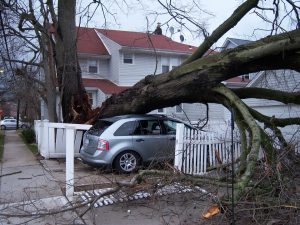 Courtesy of iii.org
Courtesy of iii.org
Hurricane season takes place June 1 – November 30 every year. Don’t wait until after you have a loss to check your insurance—review your homeowners or renters policies to make you have the right coverage in the event you’re hit with a destructive storm.
Make sure your home’s structure has adequate coverage
Standard homeowners insurance covers the structure of your house for disasters such as hurricanes and windstorms, along with a host of other disasters. It’s important to understand the elements that might affect your insurance payout after a hurricane, and adjust your policies accordingly.
- Check your homeowners policy limit and make sure the amount is enough to rebuild your home – The cost of rebuilding or extensively repairing a home is dependent on a number of factors—and, remember that the real estate value of a house is notthe same as the cost to rebuild. Therefore, it pays to understand in detail what it will cost to rebuild in the event your house is severely damaged or destroyed and make sure your insurance will cover that amount.
- Understand your hurricane/windstorm deductible – Insurers in every coastal state from Maine to Texas include separate deductibles for hurricanes and/or windstorms in their homeowners policies, stated on the Declarations (front) page of your homeowners policy.
A hurricane deductible is applied only to hurricanes, whereas a windstorm deductible applies to any type of wind. If your policy has a hurricane deductible, it will clearly state the specific “trigger” that would cause the deductible to go into effect.
Unlike the standard “dollar deductible” on a homeowners policy, a hurricane or windstorm deductible is usually expressed as a percentage, generally from 1 to 5 percent of the insured value of the structure of your home.
If you live in an area at high risk for hurricanes, your hurricane deductible may be a higher percentage. Depending on your insurer and the state where you live, you may have the option of paying more money in premiums in exchange for a lower deductible.
Like any deductible, a hurricane or windstorm deductible will affect the bottom line of your insurance payout. If you have a high hurricane or windstorm deductible consider putting aside the additional money you may need to rebuild your home.
- Understand what disasters your insurance policy covers—and those it doesn’t – Standard homeowners insurance policies provide coverage for hurricanes, wind, theft, fire, explosion, lightning strikes and many other disasters. However, all policies also list exclusions, which are events NOT covered by the policy.
One common exclusion is flooding. People tend to underestimate this risk, but 90 percent of all natural disasters—especially hurricanes—include some form of flooding. If you live in a flood zone or a hurricane-prone area, a separate flood insurance policy is a must.
Another common exclusion is sewer backups (which is also not covered by flood insurance) Sewer backup insurance is also good to have in hurricane-prone areas.
Get to know all of the exclusions in your policy and either talk to your insurance professional about purchasing separate coverage, or be prepared to pay out of pocket for the damages that are excluded in your policy.
- If you own a co-op apartment or condo – check with your management company and the bylaws to understand what is covered under the building’s master insurance policy versus what damages you need to cover in your own co-op or condo owners insurance policy.
Make sure your possessions are adequately insured
Imagine the cost of repurchasing all of your furniture, clothing and other personal possessions. Whether you have homeowners insurance or renters insurance, your policy provides protection against loss or damage due to a hurricane.
- Determine the value of your possessions with a home inventory – Creating a full inventory of your belongings and their value will make it easy to see if you are sufficiently insured for either replacement cost or cash value of the items. It will also help speed the insurance claims process and help provide proof of losses for tax or disaster aid purposes.
- Review your policy to ensure you’re adequately covered – Homeowners policies provide approximately 50 to 70 percent of the amount of insurance you have on the structure of your home. If you rent, know that your landlord’s insurance will only cover the structure of your home—you need a renters policy to protect your possessions against loss or damage.
Make sure your policy provides enough coverage for additional living expenses
Additional living expenses (ALE) covers the extra costs incurred if you need to live elsewhere because your home is rendered uninhabitable as the result of a hurricane (or any other insured disaster). While your home or apartment is being repaired or rebuilt, ALE covers hotel bills, restaurant meals, etc.—expenses over and above what your customary living expenses would be at home. Generally, the ALE policy limit is 20 percent of the amount of insurance coverage on the structure of your home. Standard renters policies also provide for ALE.
- Most insurers offer the option of higher coverage limits – Depending on where you live (which may dictate your expenses), you may want to consider a higher ALE.
- ALE reimbursements may be limited to a specified amount of time – Make sure you’re comfortable with the time limits in your policy.
- If you rent out part of your home, ALE coverage also reimburses you for lost rental income. Make sure your policy reflects the current amount of your rental income.



